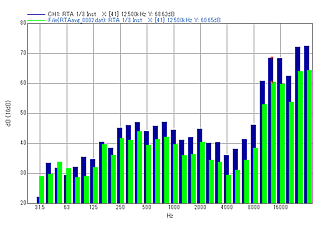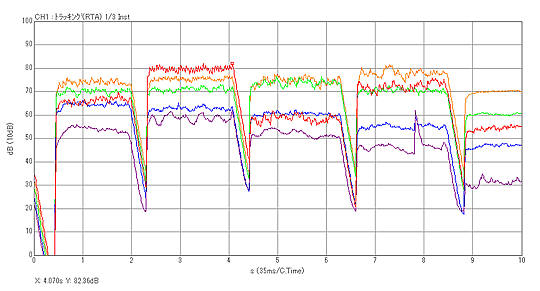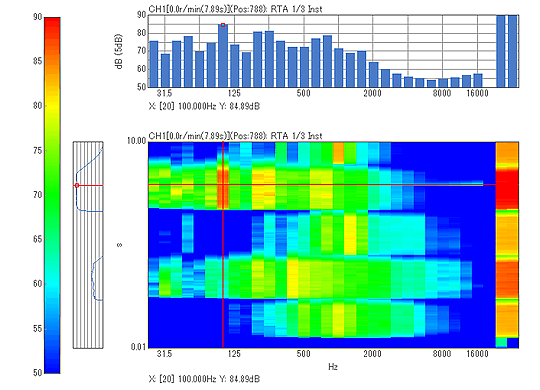Real-time 1/1, 1/3
Octave Analysis Software
DS-0323

Example of Noise Measurement Data for an Arterial Highway
Blue: Equivalent continuous A-weighted sound pressure level (Laeq)
Green: Single-shot sound exposure level (Lae)
This software analyzes the 1/1 and 1/3 octave bands for 2 - 32 channels (2 - 64 channels when two units are connected ) in real-time from 0.5 to 20 kHz. The filter is compatible with the IEC, JIS, and ANSI standards. The equivalent continuous A-weighted sound pressure level (Laeq) and the single-shot sound exposure level (Lae) are calculated simultaneously by setting measurement time. Variations in level (time series) for each band can be saved for up to 2,000 points.
The software runs under Windows XP/Windows Vista/Windows 7 (32-bit version only). Functionality can be expanded to rotation and tracking analysis with the real-time octave band by adding the optional software DS-0324 and DS-0322.
* The equivalent continuous A-weighted sound pressure level is an average level obtained by dividing the total level for duration t by t. The single-shot sound exposure level is a value obtained by converting the duration t level to the level for a duration of one second. Real-time octave analysis
Real-time octave analysis requires frequency analysis when developing measures to deal with noise. Octave analysis has been employed for noise analysis for a considerable time. An octave is a frequency ratio of 1:2, i.e. it is twice the frequency.
The human ear hears equal ratios of frequencies. An octave band series is therefore standardized relative to 1 kHz, and the sound pressure level for each band found with a band pass filter in accordance with the standard. The 1/1 octave band is the octave band relative to 1 kHz. The 1/3 octave band is obtained by dividing the 1/1 octave band into three.

Example of color mapping of level trends

Applications for Real time Octave Analysis
Specification
(1) Input section
Number of channels |
32 channels at maximum (simultaneous processing):with one unit |
|---|---|
| Input impedance | 1 MΩ / approx. 120 pF |
| Input voltage range | Applied every 10 dB, in 6 steps |
| Input connector | BNC voltage input, applicable to CCLD 2 mA, 4 mA |
| Frequency weighting | A, C and Z (FLAT), analog filter |
| Sensitivity setting | Settable for each channel (calibration function) |
(2) Filter and detection section
| Calculation method | All digital calculation method (Digital filter and Digital RMS) |
|---|---|
| A/D conversion | 24 bit, 64 kHz sampling |
| Filter type | 6th butterworth |
| Conforming standards (Filter) | JIS C 1514-2002 Class 1 IEC 61260 Ed.1.0 (1995) Class 1 ANSI S1.11-2004 Class 1 |
| Frequency range | 0.5 Hz to 20 kHz (1/3 OCT) 1.0 Hz to 16 kHz (1/1 OCT) |
| Time constant | 10 ms, 35 ms, FAST (125 ms), 630 ms, SLOW (1 s), 8 s, IMPULSE |
(3) Measurement section
| Measurable physical characteristics of sound | Sound pressure level for each band |
|---|---|
| Basic measurement | INST (Instantaneous value), MAX (Maximum value for each second) |
| Second processing | Differential function(Difference of dB value, difference of antilog value (background noise correction) Level trend function (Plotting the graph showing level changing in arbitrary band, second processing after memorized) |
(4) Display section
Display format |
Bar graph display (Allband+Allpass+Overall) |
|---|
(5) Memory section
Memory capacity |
4000 blocks Continuous recording of INST data (level trend function) |
|---|---|
| Recording interval | 1 ms to 10 s (variable) |
| Display data file | The folder and file name to be saved can be specified |
(6) Data input/output function
Analysis condition file |
Open/save of arbitrary measurement condition file |
|---|---|
| Print function of data | Print function by installing of printer driver |
| Copy function of data | Pasting data on clipboard at text or bitmap format |
(7) Operating environment
OS(Operating System) |
Microsoft® Windows® 10 version 21H1 SAC Pro(64-bit) Other editions such as Enterprise, Education, Enterprise 2019 LTSC, etc. need to be discussed individually. |
|---|---|
| NET Framework | .NET Framework 3.5 or later |
*Windows®, Windows Vista® are registered trademarks of Microsoft Corporation in the United States and other countries.
Other product names and model names are trademarks or registered trademarks of each individual company. The copy rights are reserved by each individual company.
Revised:2021/10/26
